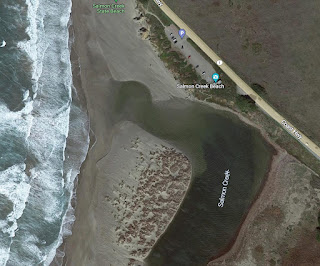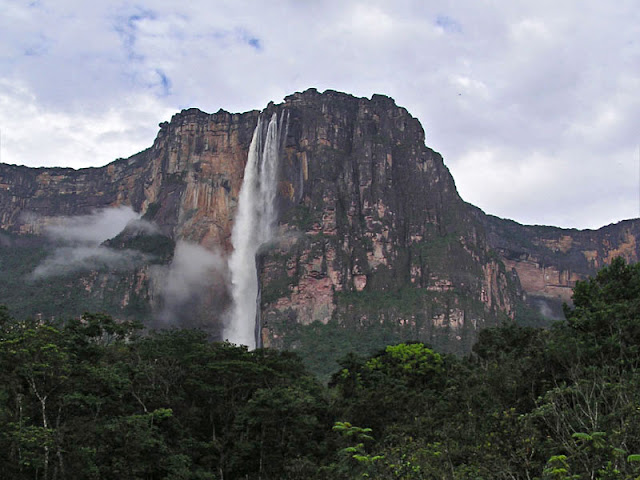Rivers ultimately flow to the sea..
... except when they don't.
As the pair of pictures above show, the thing about these places is that they are often closed off from free flow between the mountains and the sea. Sometimes a big pile of sand and sediment will block the connection between the river and the ocean. See the first image above.
But as you can see in the second image, sometimes that pile of sand is washed away, and the river is re-connected with the sea.
If you look at many rivers (at least in California), sometimes they're open, sometimes they're closed. From my observations over the years, the closures vary by time of year, but these rivers are open about half the time.
*
A common problem in SearchResearch Challenges is knowing what you're trying to ask about. As you know, your searches will be much more effective if you know the right terms.
The REAL Challenge for this week is to come up with a term that's sufficiently exact to be useful in learning more about the topic. But if you don't know what something is called, how do you start your searching? This is always the problem when we start searching for something we don't know much about. It's the initial search problem.
Can you figure out what good search query terms might be for this pile of sediment??
1. What is this pile-of-sand blocking the river called? Are there any synonyms for this thing?
As always, I began this search by describing what I see in the images in the most straightforward way possible.
[ pile of sediment that forms at the mouth of a river ]
The results from this query suggest that this is a delta. But as I read through many of the results, it's clear that a "delta" is a large fan-shaped deposition of sediment that forms (and reforms), but never really blocks the river. I quickly checked this by searching for images of [ river delta ] and confirming that interpretation.
I tried substituting "sand" for "sediment" and got much the same results.
BUT.. as I read a bit farther down the SERP, I saw the term "sandbar." All of the examples I was looking at (all of those rivers in the original post ran into a sandy beach) were composed of sand!
Next search:
[ sandbar ]
where I learned that a "sandbar" is an accumulation of sand that can happen almost anywhere there's water and sand mixing it up. Sandbars most often happen just offshore from the beach or rocky coastline. They're ephemeral and can often form at the point where a river runs into the sea.
A little more looking brought me to the Britannica definition of sandbar, which ALSO taught me about a more particular set of terms bay-mouth bar, and tombolo.
The tombolo is a sandbar that connects the beach (or mainland) to an island (of any size). It doesn't necessarily close off the mouth of a river.
By contrast, a bay-mouth bar (or baymouth bar) CAN close off the mouth of a bay--or the large exist of a river to the sea!
This made me wonder--if "bay-mouth bar" is a thing, is there a more specific term just for rivers? That is, is "river mouth bar" a thing as well?
A quick search for [ river mouth bar ] took me to the Wikipedia page on Mouth bars where I learned that a bar in a river is an elevated region of sediment (such as sand or gravel) that has been deposited by the flow. At the point where the ocean and river meet, a sandbar can form across the mouth of the river, effectively closing it off.
There's a fascinating section in the Wikipedia page on Mouth bars that details how different kinds of bars form (is the river fast or slow? does it have a lot of silt, or does it primarily carry gravel? what angle does the river hit the ocean?) The answers to these questions tell us whether the bar will be a simple bar just offshore, or form a river mouth bar, or a bay mouth bay, OR.. if the river is slow enough, the sea calm enough, and the carried sediment small enough, it might begin building a delta.
So that's the answer--a sandbar that closes off the mouth of a river where it reaches the sea is a river mouth bar, a very specific kind of sandbar at an exact location.
2. If these rivers open and close intermittently, what is the effect on the fish population? Have they evolved to expect this semi-random open/closing? What happens to the poor fish when this happens?
For a question like this, Google Scholar is your friend. I turned to Scholar.Google.com and did a query for:
[ river mouth bar estuary changes ]
I added the word estuary because I wanted to find articles that talk about marine life changes in the zone around the river mouth bar (which is called an estuary).
This search finds a lot of relatively sophisticated papers and articles about how periodic river mouth closures affect the life that gets trapped behind the closed off river.
One paper in particular caught my eye as it was about the Russian River, which happened to be one of the rivers I used in the Challenge post. The paper is Episodic closure of the tidal inlet at the mouth of the Russian River — A small bar-built estuary in California, by Behrens, et al.
 |
| The mouth of the Russian River, near Jenner, CA. Shown in the open condition as it flows to the sea, this is the subject of the paper discussed below. P/C Google Maps. |
In this paper the authors write that:
A hallmark of these systems is their intermittent connectivity with the ocean, as waves periodically block the inlet channel with sediment. Despite this variability, these systems are vital for many species that have adapted to and thus take advantage of the closed inlet conditions (Becker et al., 2009).
In western North America, the state of the inlet is increasingly recognized as a critical factor for endangered salmonid populations, which migrate into the estuary and upriver to spawn in seasons when the inlet is typically open, but may also use the lower estuary as a nursery when the inlet is closed during the dry season (Hayes et al., 2008).
In addition to preventing navigation and fish passage between the ocean and the lagoon, inlet closures prevent tides from entering the estuary, which can have significant impacts on estuarine mixing, circulation and flushing (e.g., Ranasinghe et al., 1999) — as well as negative impacts on water quality in the presence of pollutant loading.
The periodic closures can have a bit effect on estuary life! Not a surprise.
What DID surprise me was the paper by Becker, et al (cited above), Artificial mouth opening fosters anoxic conditions that kill small estuarine fish is all about the effects of opening and closing a river mouth bar and how a closed-off river mouth can create a zone of water with low oxygen, which can kill fish.
But on the other hand, that crummy water also has the side-effect of driving fish that would normally live in the estuary farther up-river, letting them recolonize sections of the river that they'd previously left. (Water with oxygen is much better than anoxic waters!) As the authors write:
"It also appears that many of the small estuarine resident species common in seasonally open estuaries are capable of recolonising estuaries following fish kills [during the river mouth closure]..."
So, the short answer is that, unsurprisingly, the fish have adapted to the periodic open/closed river mouth. In fact, the closures might well help move encourage fish to move around a bit and occupy territory they otherwise would not, which can then be useful after the river mouth reopens its passage to the sea.
SearchResearch Lessons
1. Keep your initial searches as simple as possible. Don't try to be too fancy, especially with words that you're not 100% sure of their meaning.
2. When reading articles that are near to your desired topic, keep your eyes open. You might well find terms and concepts that are the key to unlocking your Challenge. In particular, if you see something that you do NOT recognize, check it out. Sometimes those words that aren't known to you might well have gems of meaning within them.
2. Quickly check your initial read to be sure it's what you seek. My image search for [river delta] told me that this wasn't the term I sought. In this case, I used a quick image search to see what river deltas look like--it was pretty clear that that was not what I wanted, and I was able to continue my SearchResearch fairly quickly.
Keep searching!



















